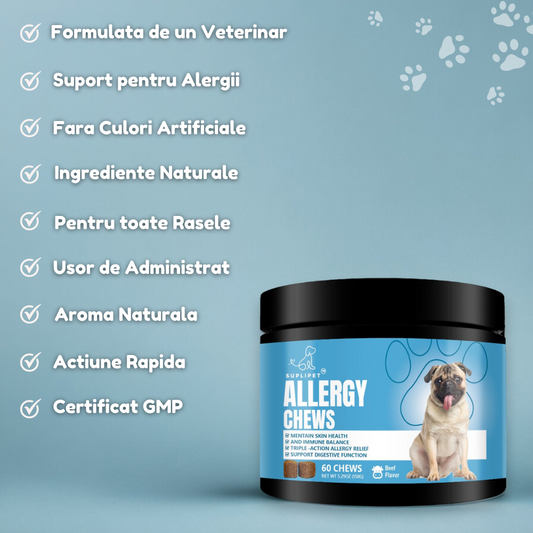Training your dog is one of the most gratifying and important elements of dog ownership. It promotes a peaceful relationship, encourages good conduct, and improves the bond between you and your pet. This thorough guide will teach you the important principles and tactics for effective dog training, including basic commands, positive reinforcement systems, the necessity of socialization, and the role of supplements in training.

Basic commands that every dog should know
Starting with fundamental commands is critical because they create the groundwork for more complex training and can help prevent many behavioral disorders. Here are the key commands that every dog should know and how to effectively teach them:
- Sit
Teaching your dog to sit on command is one of the first steps toward establishing control. This command is useful in a variety of settings, including eating, greeting guests, and avoiding jumping on humans.
How To Teach "Sit":
• Hold a reward near your dog's nose.
• Raise your hand, forcing its head to follow the treat and its bottom to descend.
• When they sit, say "Sit," reward them with a treat, and praise them.
• Repeat this daily until your dog understands the command. - Stay
Once your dog can sit, the "Stay" command teaches them self-control. This command is critical for safety, keeping your dog from getting into harmful situations or being overly excited.
How To Teach "Stay":
• Ask your dog to sit.
• Open your palm and say "Stay."
• Take a couple of steps backward. If they stay, offer them a treat and praise.
• Gradually increase the required distance and period of stay.
• Regular practice reinforces desired behavior. - Come
A reliable recall command is essential. It assures that your dog returns to you, which is critical for their protection, particularly when off-leash.
How to Teach "Come"?
• Use a leash and collar for your dog.
• Gently pull the leash and say "Come".
• Reward the dog with a treat and praise.
• Practice in a safe, contained environment without a leash after they answer consistently. - Leave it.
Teaching your dog to leave stuff alone on command will help them avoid swallowing toxic chemicals and handle resource-guarding habits.
How to Teach "Leave It"?
• Hold a goodie in each hand.
• Show your dog an enclosed fist with a goodie inside and say, "Leave it."
• Ignore any attempts to obtain the treat.
• When they quit trying and move away, give them the treat with the other hand.
• Practice until they immediately respond to commands.
Consistency is essential when practicing these commands. Use the same words and gestures every time, and rehearse in different settings to generalize the behavior.
Positive Reinforcement
Positive reinforcement is often regarded as the most efficient training strategy. It entails rewarding your dog for desired behaviors, which makes them more inclined to repeat those behaviors in the future. Here's how to use positive reinforcement effectively:
Treats and Praise. Use high-value treats.
• Select your dog's favorite snacks, such as little bits of chicken, cheese, or specifically made dog biscuits.
• Use incentives and verbal praise to reinforce the behavior. Over time, you can minimize the number of treats and rely on praise.
Timing:
- Provide immediate rewards for your dog's desired behavior. This allows them to correlate the behavior with the reward.
• Use a marker phrase, such as "Yes!" or a clicker, to indicate the exact instant the behavior is accomplished.
Consistency
Consistency is vital for positive reinforcement. If you reward your dog for sitting one day but not the next, he or she may become confused.
• Use consistent commands and rewards throughout the home to prevent confusion.
Positive reinforcement increases trust and enhances your bond with your dog. It also fosters a good learning environment in which your dog feels comfortable and eager to learn.
Socialization is key
Adequate socializing is essential for a well-rounded dog. Exposing your dog to various locations, people, and animals helps to reduce anxiety and aggression in novel situations. Here are some ideas for successful socialization:
Early Exposure. Start Early:
- Start socializing your dog as soon as possible. Puppy programs are fantastic opportunities for supervised socialization with other dogs and people.
• Introduce your dog to people of varied ages, genders, and clothing styles.
Gradual introductions. Controlled environments:
• Don't overwhelm your dog with new experiences. Introduce them gradually.
• Use sweets and praise to ensure a happy experience. For example, while meeting new people, give strangers food to offer your dog.
Expose your dog to diverse locations, sounds, and situations, including busy streets, parks, and other animals.
• Take your dog on regular vehicle rides, walks in other neighborhoods, and visits to friends' homes.
Proper socialization ensures that your dog is confident and comfortable in a variety of situations, which reduces the probability of behavioral problems.

Supplements for Training Support
Supplements can help your dog focus and be less anxious during training. Here are several supplements that can improve your training.
- L-Theanine, an amino acid contained in green tea, can lower anxiety and increase relaxation without inducing sleepiness. It is especially beneficial for dogs who are easily distracted during training.
- Chamomile, known for its relaxing characteristics, can assist stressed dogs stay focused during training sessions. It is available in tea and supplement form.
- B vitamins can boost energy and attention by supporting the neurological system. They are especially good for energetic dogs and those undergoing extensive training.
- Consult your veterinarian before using any supplements to confirm they are safe and appropriate for your dog's needs.
We recommend you use supplements from www.suplipet.shop
Advanced Training Techniques
After your dog has mastered the fundamental commands, you can progress to more complex training techniques to improve their skills and conduct.
Clicker Training: Precision and Timing.
• Clicker training uses a small device with a clicking sound to mark desired behaviors.
• The clicker signals the exact time your dog accomplishes a desired behavior, followed by a reward.
Shaping in Gradual Learning includes rewarding repeated approximations of desired behavior. For example, if you want your dog to fetch a toy, you can reward them for looking at it, touching it, and finally taking it up.
• This strategy simplifies complex activities into simple, manageable steps.
Target training is teaching your dog to touch a specific object with their nose or paw. This approach can be used to guide them through obstacle courses, teach new behaviors, and concentrate their attention.
Managing Behavioral Issues
Training also entails addressing and fixing behavioral problems. Here are some frequent issues and ways to address them:
Identifying Triggers:
- Determine what causes your dog's barking. Boredom, worry, and external cues such as passing cars or animals are all common triggers.
• Address the root cause by increasing exercise, mental stimulation, or desensitizing to the trigger.
Chewing is a natural way for puppies and dogs to explore their surroundings and relieve discomfort from teething or boredom.
• Encourage your dog to gnaw on appropriate toys instead of inappropriate items.
Jumping
Teaching Appropriate Greetings: • Dogs frequently jump to greet or seek attention. Teach them to sit instead of greeting.
• Reward your dog with attention only when they are calm and seated, and ignore jumping behaviors.
To train your dog to walk on a loose leash, pause and change direction whenever they pull. Reward them when the leash is loose. Consistency and patience are essential for educating your dog to walk gently on a leash.
Creating a strong bond
Training your dog entails more than just teaching commands and correcting behavior; it's also about developing a strong, trustworthy bond. Here are some ideas to strengthen the bond with your dog during training:
Spend quality time. Engage in Activities Together: • Spend quality time with your dog beyond training sessions. Engage in enjoyable activities like fetch, hiking, or cuddling to foster trust and cooperation.
Understand their needs.
Learn to read your dog's body language to identify their wants and emotions. Recognize the symptoms of stress, excitement, relaxation, and discomfort.
• Responding to your dog's signs promotes greater understanding and connection.
Be patient and consistent.
Training needs patience and consistency. Dogs learn at varying rates, and certain commands may take longer to master than others.
• Celebrate little achievements while staying consistent with training methods and expectations.
Positive interactions. Create positive associations:
• Ensure positive training sessions for your dog. Avoid severe penalties or unpleasant interactions, as these might harm the bond and instill dread.
• Create a positive learning environment for your dog by using positive reinforcement to make them feel safe and motivated.

The Value of Ongoing Training
Training is a continual process that does not end once your dog understands the fundamental commands. Continuous training engages your dog's thinking, reinforces positive behavior, and improves your bond. Here are some strategies to continue teaching your dog throughout their life:
Refresh basic commands with regular practice.
• Regularly practice fundamental instructions to maintain their sharpness. Incorporate these commands into your dog's everyday routine, such as having him sit before meals or staying while you answer the door.
• Regular refresher sessions promote positive behavior and preserve obedience.
Teach new tricks.
Teaching new tricks stimulates your dog's mind and pushes their problem-solving skills. Rolling over, pretending to be dead, and recovering certain items are all enjoyable and entertaining tricks.
• To learn difficult skills effectively, use positive reinforcement and divide them down into simple steps.
Advanced Training Classes.
For more education, consider participating in advanced training classes such as agility, obedience competitions, or scent work. These courses provide scheduled study and socialization opportunities.
•Advanced training enhances your dog's present talents while also providing new challenges to keep them involved.
Address new behaviors. Adapt to Changes:
•As your dog ages or their environment changes, they may develop new behaviors. These habits should be addressed as soon as possible using suitable training strategies.
•Maintain a proactive approach to monitoring and guiding your dog's behavior to ensure a well-adjusted and happy companion.
Conclusion
Training your dog involves patience, consistency, and positive reinforcement. Starting with basic commands, using positive reinforcement methods, assuring correct socialization, and considering supporting supplements will help you create a solid, trusting relationship with your furry buddy. Continuous training and interaction will ensure that your dog remains a well-behaved and content member of your family. Accept the art of dog training and get the benefits of a peaceful and enriching existence with your canine companion.
-
Regular price$19.00Regular price
$24.00Sale price$19.00 Save $5.00 (20%)Unit priceperHip & Joint Chews 45kg+ Dogs
-
Regular price$23.00Regular priceSale price$23.00 Save $-23.00 (%)Unit priceper
Allergy Chews Dogs
-
Regular price$18.00Regular price
$23.00Sale price$18.00 Save $5.00 (21%)Unit priceperProbiotic Chews Dogs
-
Regular price$17.00Regular price
$21.00Sale price$17.00 Save $4.00 (19%)Unit priceperCalming Chews Dogs











